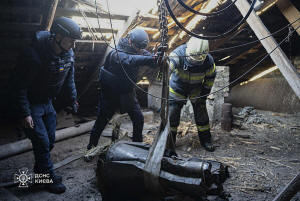What does Biden's decision to allow Ukraine to use longer-range US
weapons mean?
 Send a link to a friend
Send a link to a friend
 [November 19, 2024]
By SAMYA KULLAB [November 19, 2024]
By SAMYA KULLAB
KYIV, Ukraine (AP) — The U.S. will allow Ukraine to use
American-supplied longer-range weapons to conduct strikes deeper inside
Russian territory, a long-sought request by Kyiv.
It isn't yet clear if there are limits on Ukraine's use of the Army
Tactical Missile System, or ATACMS, as there have been on other U.S.
missile systems. Their deployment could — at least initially — be
limited to Russia's Kursk region, where Ukrainian troops seized
territory earlier this year.
Since the first year of the war, Ukrainian leaders have lobbied Western
allies to allow them to use advanced weapons to strike key targets
inside Russia — which they hope would erode Moscow’s capabilities before
its troops reach the front line and could make it more difficult for the
Russian forces to strike Ukrainian territory. It could also serve as a
deterrent force in the event of future cease-fire negotiations.
The U.S. has long opposed the move, with President Joe Biden determined
to avoid any escalation that he felt could draw the U.S. and other NATO
members into direct conflict with nuclear-armed Russia. The Kremlin
warned on Monday that the decision adds “fuel to the fire.”
The decision comes in the waning days of Biden’s presidency, before
President-elect Donald Trump assumes office. Trump has said he would
bring about a swift end to the war, which many fear could force
unpalatable concessions from Kyiv.

What are ATACMS?
The ballistic missiles, developed by U.S. aerospace and defense company
Lockheed Martin, have nearly double the striking distance — up to 300
kilometers (190 miles) — of most of the weapons in Ukraine's possession.
They carry a larger payload and have more precise targeting for pinpoint
attacks on air fields, ammunition stores and strategic infrastructure.
The United States has supplied Ukraine with dozens of ATACMS (pronounced
attack-ems) and they have been used to destroy military targets in
Russian-occupied parts of Ukraine such as Crimea — but not on Russian
soil.
What is Biden allowing Ukraine to do?
Biden authorized Ukraine to use the ATACMS to strike deeper inside
Russia, according to a U.S. official and three other people familiar
with the matter.
The longer-range missiles are likely to be used in response to North
Korea’s decision to send troops to support Kremlin forces, according to
one of the people familiar with the development. Pyongyang’s troops are
apparently being deployed to help the Russian army drive Ukrainian
forces out of Russia’s Kursk border region, where they launched an
incursion in August.
The officials spoke on condition of anonymity because they were not
authorized to discuss the U.S. decision publicly.
It was the second time that Washington has expanded Ukraine's authority
to use its U.S.-provided weapons systems inside Russian territory.
In May, after Russia’s offensive into the Kharkiv region threatened to
stretch Ukrainian forces thin, Biden permitted the use of HIMARS systems
— with a range of 80 kilometers (50 miles) — to quell that advance. That
decision helped Ukrainian soldiers stabilize the fight for a time by
forcing Russian forces to pull back military assets.

Why does Ukraine need longer-range weapons?
Ukraine has been asking its Western allies for longer-range weapons in
order to alter the balance of power in a war where Russia is better
resourced, and strike with precision air bases, supply depots and
communication centers hundreds of kilometers (miles) over the border.
It hopes the weapons would help blunt Russia’s air power and weaken the
supply lines it needs to launch daily strikes against Ukraine and to
sustain its military ground offensive into Ukraine.
If used in Kursk, the weapons would likely require Russian forces
preparing for counterattacks to push back valuable equipment and
manpower and complicate battle plans.
In lieu of Western weapons, Ukraine has been regularly striking Russia
with domestically produced weapons, with some capable of traveling up to
1,000 kilometers (620 miles), but still lacks sufficient quantities to
do serious long-term harm.
[to top of second column]
|

In this photo provided by the Ukrainian Emergency Service, emergency
services personnel remove part of a Russian missile that hit an
apartment house during massive missile attack in Kyiv, Ukraine,
Sunday, Nov. 17, 2024. (Ukrainian Emergency Service via AP)

Will the decision change the course of the war?
Ukrainian leaders are being cautious about the announcement — and
senior U.S. defense and military leaders have persistently argued
that it won't be a gamechanger. They also have noted that Russia has
moved many key assets out of range.
“I don’t believe one capability is going to be decisive and I stand
by that comment,” Defense Secretary Lloyd Austin has said, noting
that the Ukrainians have other means to strike long-range targets.
Analysts have also suggested the effect could be limited.
“Today, many in the media are talking about the fact that we have
received permission to take appropriate actions. But blows are not
inflicted with words. Such things are not announced. The rockets
will speak for themselves,” said Ukrainian President Volodymyr
Zelenskyy of the announcement.
The effect of the decision depends on the rules set for the weapons'
use.
If strikes are allowed across all of Russia, they could
significantly complicate Moscow's ability to respond to battlefield
demands.
If strikes are limited to the Kursk region, Russia could relocate
its command centers and air units to nearby regions, blunting the
effect of those logistical challenges. That would also mean many of
the valuable targets Ukrainian officials have expressed desire to
hit may still be beyond reach.
Either way, Pentagon spokesman Lt. Col. Charlie Dietz has noted the
ATACMS wouldn’t be the answer to the main threat Ukraine faces from
Russian-fired glide bombs, which are being fired from more than 300
kilometers (180 miles) away, beyond the ATACMS' reach.

In addition, the overall supply of ATACMS is limited, so U.S.
officials in the past have questioned whether they could give
Ukraine enough to make a difference — though some proponents say
that even a few strikes deeper inside Russia would force its
military to change deployments and expend more of its resources.
Jennifer Kavanagh, director of military analysis at Defense
Priorities, said the U.S. decision would not alter the course of the
war.
“To really impose costs on Russia, Ukraine would need large
stockpiles of ATACMS, which it doesn’t have and won’t receive
because the United States’ own supplies are limited," she said.
“Moreover, the biggest obstacle Ukraine faces is a lack of trained
and ready personnel, a challenge that neither the United States nor
its European allies can solve and that all the weapons in the world
won’t overcome.”
What are the key remaining questions?
In addition to it being unclear what, if any, restrictions the U.S.
will impose on the weapons’ use, it’s also not known how many the
U.S. will give to Ukraine.
While the U.S. has provided ATACMS to Ukraine in various military
aid packages, the Defense Department will not disclose how many have
been sent or exactly how many of those missiles the Pentagon has.
Estimates suggest the U.S. has a number that is in the low
thousands.
The recent American election raises questions over how long this
policy will be in place. Trump has repeatedly criticized the Biden
administration’s spending to support Ukraine — and could reverse
moves like this one.
On the other hand, it’s also not clear whether other allies might
step up: The decision may encourage Britain and France to allow
Ukraine to use Storm Shadow missiles, also known as SCALP missiles,
with a range of 250 kilometers (155 miles).
All contents © copyright 2024 Associated Press. All rights reserved
 |